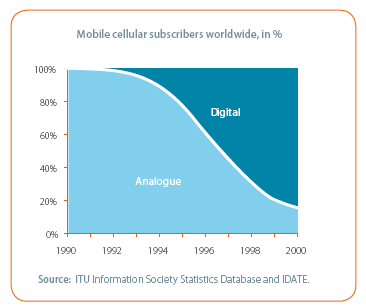|
chapter
five: living the digital world
The telecommunications industry began as a digital-only
world. The dots and dashes of the electronic telegraph that
“made the world one”, in Arthur C. Clarke’s famous phrase,
were not only digital in nature; they were also generated by
the “digits” of an army of telegraph operators around the
world. Between the invention of the telephone, in 1876, and
the development of the first digital switch, exactly 100
years later, the telecommunications industry took an
analogue detour. But rapid innovation over the last few
decades indicates that the digital world is firmly back on
track. And although the transition from the analogue to the
digital world is not yet
 complete,
the direction of change is clear and irreversible. complete,
the direction of change is clear and irreversible.
A digital world poses a number of important challenges. For
instance, the increasing complexity of technology should not
be at the expense of basic simplicity of use. The
development of user-friendly systems must be encouraged, in
order to ensure that a maximum number of people can use
digital technology with a minimum amount of training. Only
then can we be sure that the process of going digital is
both inclusive and global and that the transition between
the old and the new is smooth and rapid.
Another important challenge to the digital world is ensuring
regulatory consistency, particularly in an environment of
rapid technological change. This includes considerations
related to technological neutrality, market definitions,
regulatory timing and regulatory forbearance. The borderless
spaces of the digital world also raise concerns about
content, in particular the kind of “frontiers” we may wish
to maintain in order to mirror, or reinforce, known
frontiers in the offline (physical) world. Convergence (as
reflected in services like mobile and internet TV) is
bringing together three different regulatory cultures: the
content-regulated culture of the broadcasting sector, the
carrier-led culture of telecommunications, and the
“regulation is interference” culture of the internet.
Needless to say, it is a potentially explosive mix. A final
challenge is to extend the benefits of digital lifestyles to
all the world’s inhabitants: by enabling everyone,
everywhere, not only to access and utilize information and
knowledge, but also to create and share it.
In order to gain a glimpse of how digital lifestyles might
continue to evolve, an example of a typical “digital day”,
at some unspecified time in the future, is illustrated
overleaf. Ultimately, the digital world is a user-driven one
in which consumers who are not happy with a particular
service provider or website can easily switch to another. It
is a footloose world, with a very low cost of switching for
users and a relatively low cost of entry for service
providers. It is a world in which traditional barriers to
communication, like geography, language and social class,
disintegrate. What is more, users can also participate in
creating their own services and content. In the physical
world, the height of most people’s ambition is to find
proper employment, develop a hobby, purchase a home of one’s
own, decorate it to reflect a chosen lifestyle, and fill it
with their friends and family. We can now do this in the
digital world too. So perhaps digital dreams are not so
different, after all.
|